-

新人教版高中英语选修2Unit 3 Reading for writing教学设计
The theme of this part is to write an article about healthy diet. Through reading and writing activities, students can accumulate knowledge about healthy diet, deepen their understanding of the theme of healthy diet, and reflect on their own eating habits. This text describes the basic principles of healthy diet. The author uses data analysis, definition, comparison, examples and other methods. It also provides a demonstration of the use of conjunctions, which provides important information reference for students to complete the next collaborative task, writing skills, vivid language materials and expressions.1. Teach Ss to learn and skillfully use the new words learned from the text.2. Develop students’ ability to understand, extract and summarize information.3. Guide students to understand the theme of healthy diet and reflect on their own eating habits.4. To guide students to analyze and understand the reading discourse from the aspects of theme content, writing structure, language expression, etc., 5. Enable Ss to write in combination with relevant topics and opinions, and to talk about their eating habits.1. Guide students to analyze and understand the reading discourse from the aspects of theme content, writing structure, language expression, etc.2. Enable them to write in combination with relevant topics and opinions, and to talk about their eating habits.3. Guide the students to use the cohesive words correctly, strengthen the textual cohesion, and make the expression fluent and the thinking clear.Step1: Warming upbrainstorm some healthy eating habits.1.Eat slowly.2.Don’t eat too much fat or sugar.3.Eat healthy food.4.Have a balanced diet.Step2: Read the passage and then sum up the main idea of each paragraph.

新人教版高中英语选修2Unit 4 Learning about Language教学设计
This section guides students to pay attention to the typical context of vocabulary use, helps students accumulate vocabulary around the key vocabulary of this unit, and uses the learned words and word chunks in different contexts to deeply understand their meaning and usage, so as to achieve the purpose of review and consolidation.The teaching design activities aim to guide students to pay attention to the typical context in which the target vocabulary is used, as well as the common vocabulary used in collocation, so that students can complete the sentence with correct words. In terms of vocabulary learning strategies, this unit focuses on cultivating students' ability to pay attention to collocation of words and to use word blocks to express meaning.For vocabulary learning, it is not enough just to know the meaning of a single word, but the most important thing is to master the common collocations of words, namely word blocks.Teachers should timely guide students to summarize common vocabulary collocation, such as verb and noun collocation, verb and preposition collocation, preposition and noun collocation, and so on.1. Guide students to understand and consolidate the meaning and usage of the vocabulary in the context, 2. Guide the students to use the unit topic vocabulary in a richer context3. Let the students sort out and accumulate the accumulated vocabulary, establishes the semantic connection between the vocabulary,4. Enable students to understand and master the vocabulary more effectivelyGuiding the Ss to use unit topic words and the sentence patterns in a richer context.

新人教版高中英语选修2Unit 4 Reading for writing教学设计
假定你是英国的Jack,打算来中国旅行,请你给你的中国笔友李华写一封信,要点如下:1.你的旅行计划:北京→泰山→杭州;2.征求建议并询问他是否愿意充当你的导游。注意:1.词数80左右(开头和结尾已给出,不计入总词数);2.可以适当增加细节,以使行文连贯。参考词汇:故宫 the Forbidden City;泰山 Mount TaiDear Li Hua,I'm glad to tell you that 'm going to visit China.First,I am planning to visit Beijing,the capitalof China,where I am looking forward to enjoying the Great Wall,the Forbidden City and somebeautiful parks.Then I intend to go to visit Mount Tai in Shandong Province.I've heard that it is one ofthe most famous mountains in China and I can't wait to enjoy the amazing sunrise there.After that,I amalso going to Hangzhou.It is said that it is a beautiful modern city with breathtaking natural sights,among which the West Lake is a well- known tourist attraction.What do you think of my travel plan? Will you act as my guide? Hope to hear from you soon.

新人教版高中英语选修2Unit 5 Learning about Language教学设计
The purpose of this section of vocabulary exercises is to consolidate the key words in the first part of the reading text, let the students write the words according to the English definition, and focus on the detection of the meaning and spelling of the new words. The teaching design includes use English definition to explain words, which is conducive to improving students' interest in vocabulary learning, cultivating their sense of English language and thinking in English, and making students willing to use this method to better grasp the meaning of words, expand their vocabulary, and improve their ability of vocabulary application. Besides, the design offers more context including sentences and short passage for students to practice words flexibly.1. Guide students to understand and consolidate the meaning and usage of the vocabulary in the context, 2. Guide the students to use the unit topic vocabulary in a richer context3. Let the students sort out and accumulate the accumulated vocabulary, establishes the semantic connection between the vocabulary,4. Enable students to understand and master the vocabulary more effectivelyGuiding the Ss to use unit topic words and the sentence patterns in a richer context.Step1: Read the passage about chemical burns and fill in the blanks with the correct forms of the words in the box.

新人教版高中英语选修2Unit 5 Reading and thinking教学设计
The theme of this activity is to learn the first aid knowledge of burns. Burns is common in life, but there are some misunderstandings in manual treatment. This activity provides students with correct first aid methods, so as not to take them for granted in an emergency. This section guides students to analyze the causes of scald and help students avoid such things. From the perspective of text structure and collaborative features, the text is expository. Expository, with explanation as the main way of expression, transmits knowledge and information to readers by analyzing concepts and elaborating examples. This text arranges the information in logical order, clearly presents three parts of the content through the subtitle, accurately describes the causes, types, characteristics and first aid measures of burns, and some paragraphs use topic sentences to summarize the main idea, and the level is very clear.1. Guide students to understand the causes, types, characteristics and first aid methods of burns, through reading2. Enhance students’ ability to deal withburnss and their awareness of burns prevention3. Enable students to improve the ability to judge the types of texts accurately and to master the characteristics and writing techniques of expository texts.Guide students to understand the causes, types, characteristics and first aid methods of burns, through readingStep1: Lead in by discussing the related topic:1. What first-aid techniques do you know of ?CPR; mouth to mouth artificial respiration; the Heimlich Manoeuvre

新人教版高中英语选修2Unit 5 Using langauge-Listening教学设计
The theme of this section is to learn how to make emergency calls. Students should learn how to make emergency calls not only in China, but also in foreign countries in English, so that they can be prepared for future situations outside the home.The emergency telephone number is a vital hotline, which should be the most clear, rapid and effective communication with the acute operator.This section helps students to understand the emergency calls in some countries and the precautions for making emergency calls. Through the study of this section, students can accumulate common expressions and sentence patterns in this context. 1.Help students accumulate emergency telephone numbers in different countries and learn more about first aid2.Guide the students to understand the contents and instructions of the telephone, grasp the characteristics of the emergency telephone and the requirements of the emergency telephone.3.Guide students to understand the first aid instructions of the operators.4.Enable Ss to make simulated emergency calls with their partners in the language they have learned1. Instruct students to grasp the key information and important details of the dialogue.2. Instruct students to conduct a similar talk on the relevant topic.Step1:Look and discuss:Match the pictures below to the medical emergencies, and then discuss the questions in groups.

新人教版高中英语选修3Unit 2 Healthy Lifestyle教案
Activity 4: Figuring out the structure and the writing purpose 本活动为实现课时目标2。 1.Read Paragraph 6 and think about its main idea and the writer’s writing purpose. Q1: If you were the author, how would you end your article? “For young people, there is plenty of time to change bad habits. However, there is no “magic pill” or delete button that will help you; you have to think about your bad habits and decide on some changes. You have the power to build a happy and healthy life full of good habits!” Q2: What is Paragraph 6 mainly about? (Possible answer: to appeal to young people including teenagers to change bad habits and live a happy and healthy life.) 2.Think about the writer’s writing purpose and share opinions. Q1: What is the writing purpose? Work in pairs and figure it out. (Possible answer: On the one hand, the passage is written to help teenagers change their bad habits and live a healthy lifestyle. On the other hand, it provides us with a scientific way to identify and analyse our problems objectively, thus strengthening our resolve to tackle the seemingly common yet tough problems in our lives.) 【设计意图】 步骤1旨在预测和验证文章最后一段主要内容,梳理完整的语篇结构,步骤2旨在思考和讨论作者的写作目的。教师也可根据学生课堂反应情况融入对语篇人称多次转换的思考。

新人教版高中英语选修4Unit 2 Iconic Attractions教案
帮助学生通过讨论与对主题的提升,反思自己的旅游方式,以便做出更优化的安排,在今后的旅程中有更多的收益。 Activity 2: Further discussion of the 6 elements above and supplement of more background knowledge 本活动为实现课时教学目标2。 1.Target Q: The writer’s clear target of traveling, meeting the people and experiencing the culture, is closely related to his major in social studies. Then what is social studies? Social studies is a part of a school or college curriculum concerned with the study of social relationships and the functioning of society and usually made up of courses in history, government, economics, civics, sociology, geography, and anthropology. (Dictionary by Merriam-Webster) Reflection: When you go out to travel, what targets do you usually have in mind? 2.Research Q: Suppose you are traveling to Hangzhou during the school holidays, how will you do research on the city? (surf the internet, read books or travel brochures, consult friends, ...) What information will you be interested to know? (location, iconic sites, local cuisines, interesting customs, shopping malls ...) 3.Abandonment To make the most of time, we have to learn to abandon so that we can accomplish our plan. What will you be interested in doing if you go to Hangzhou if you have a week’s time? What if you only have 2 days? 4~5. Venturing & Experiencing Q: What did he venture to do during the trip? What new experiences did he have? In Sydney: attend his first open-air barbecue, enjoy many different but yummy meals In Catherine: observe the life and customs of the aborigines appreciate their music & try the musical instruments: the didgeridoo
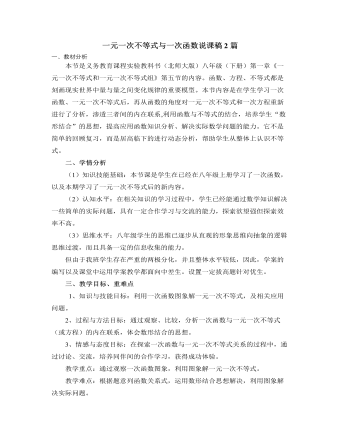
北师大版初中数学八年级下册一元一次不等式与一次函数说课稿2篇
由于任何一个一元一次不等式都能写成ax+b>0(或<0)的形式,而此式的左边与一次函数y=ax+b的右边一致,所以从变化与对应的观点考虑问题,解一元一次不等式也可以归结为两种认识:⑴从函数值的角度看,就是寻求使一次函数y=ax+b的值大于(或小于0)的自变量x的取值范围。⑵从函数图像的角度看,就是确定直线y=ax+b在x轴上(或下)方部分所有的点的横坐标所构成的集合。教学过程中,主要从以上两个角度探讨一元一次不等式与一次函数的关系。1、“动”―――学生动口说,动脑想,动手做,亲身经历知识发生发展的过程。2、“探”―――引导学生动手画图,合作讨论。通过探究学习激发强烈的探索欲望。3、“乐”―――本节课的设计力求做到与学生的生活实际联系紧一点,直观多一点,动手多一点,使学生兴趣高一点,自信心强一点,使学生乐于学习,乐于思考。4、“渗”―――在整个教学过程中,渗透用联系的观点看待数学问题的辨证思想。
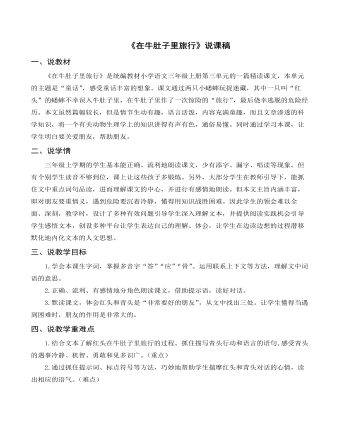
部编人教版三年级上册《在牛肚子里旅行》说课稿
二、说学情三年级上学期的学生基本能正确、流利地朗读课文,少有添字、漏字、唱读等现象。但有个别学生读音不够到位,课上让这些孩子多锻炼。另外,大部分学生在教师引导下,能抓住文中重点词句品读,进而理解课文的中心,并进行有感情地朗读。但本文主旨内涵丰富,即对朋友要重情义,遇到危险要沉着冷静,懂得用知识战胜困难。因此学生的领会难以全面、深刻,教学时,设计了多种有效问题引导学生深入理解文本,并提供阅读实践机会引导学生感悟文本,创设多种平台让学生表达自己的理解、体会,让学生在边读边想的过程潜移默化地内化文本的人文思想。三、说教学目标1.学会本课生字词,掌握多音字“答”“应”“骨”。运用联系上下文等方法,理解文中词语的意思。 2.正确、流利、有感情地分角色朗读课文,借助提示语,读好对话。
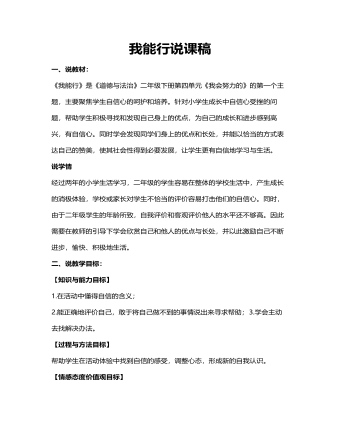
人教部编版道德与法制二年级下册我能行说课稿
师:相信我能行,这样行不行?(播放课本53页插图)“老师宣布下周长跑比赛,东东觉得自己个子高,腿长,肯定跑得快,就不打算练习了”师:东东相信自己行,所以不用练习,你们有什么看法?生:相信自己能行,也要加强练习呀!生:东东的同学不仅相信自己行,还主动练习,这样东东的同学就会赢,东东可能会输。生:光说不练,不是真的行!师:同学们说得真是太好了,不能只说行,努力才能行啊。成功靠的不仅是自信,更多的要靠努力、方法和汗水。明白了这些道理,你们才能真正做到”我能行:!师:有没有信心大声的朗读儿歌《我能行》?(学生齐读儿歌总结)(三)、作业拓展师:现在请拿出写有“我能行”的纸飞机,从今天开始,如果每天你都能坚持做到纸飞机上“我能行”的事情,就给自己画一个笑脸。坚持一周,都做到,就把纸飞机拿到空旷的地方努力的放飞,并大声的对着天空说:我能行!(提醒学纸飞机掉在地上要捡起来,注意环保)

部编人教版五年级下册《人物描写一组》说课稿
二、说教学目标及重难点:1.教学目标 :(1)自主学习字词,会认“噶、绊”等12个生字,会写“搂、仗”等15个生字,理解字义,识记字形。正确读写和理解“手疾眼快、一叉一搂、公鸡鹐架、冷绊子、挺脱、诸亲六眷、监生、一声不倒一声、已后、登时”等词语。(2)正确、流利地朗读课文,体会人物的性格特点,感受小嘎子、车夫、严监生这三个鲜活的人物形象。(3)理解课文内容,学习作者抓住人物的动作、语言、外貌、心理活动等描写人物的方法,学习表现人物某一方面特点的写作方法。(4)激发学生阅读中外名著的兴趣。2.教学重点:体会人物的性格特点,感受小嘎子、车夫、严监生这三个鲜活的人物形象。3.教学难点:学习作者抓住人物的动作、语言、外貌、心理活动等描写人物的方法,学习表现人物某一方面特点的写作方法。
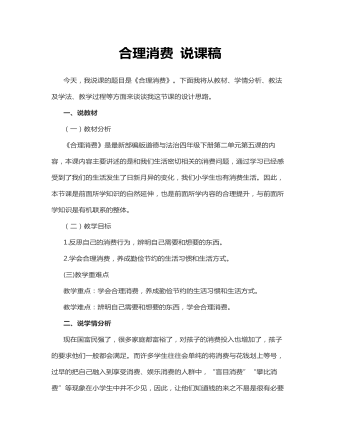
合理消费 说课稿
一、说教材(一)教材分析《合理消费》是最新部编版道德与法治四年级下册第二单元第五课的内容,本课内容主要讲述的是和我们生活密切相关的消费问题,通过学习已经感受到了我们的生活发生了日新月异的变化,我们小学生也有消费生活。因此,本节课是前面所学知识的自然延伸,也是前面所学内容的合理提升,与前面所学知识是有机联系的整体。(二)教学目标1.反思自己的消费行为,辨明自己需要和想要的东西。2.学会合理消费,养成勤俭节约的生活习惯和生活方式。(三)教学重难点教学重点:学会合理消费,养成勤俭节约的生活习惯和生活方式。教学难点:辨明自己需要和想要的东西,学会合理消费。二、说学情分析现在国富民强了,很多家庭都富裕了,对孩子的消费投入也增加了,孩子的要求他们一般都会满足。而许多学生往往会单纯的将消费与花钱划上等号,过早的把自己融入到享受消费、娱乐消费的人群中,“盲目消费”“攀比消费”等现象在小学生中并不少见,因此,让他们知道钱的来之不易是很有必要的。只有这样,才能促使学生认真思考“怎样使用手中所积攒下来的钱,才能意识到要合理消费。
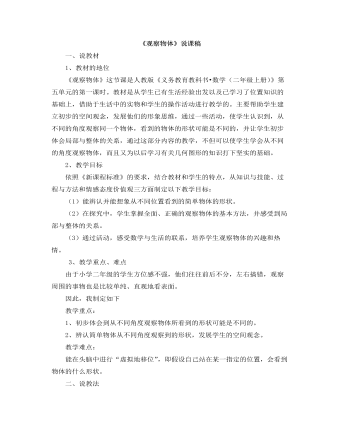
小学数学人教版二年级上册《观察物体》说课稿
1、教材的地位《观察物体》这节课是人教版《义务教育教科书?数学(二年级上册)》第五单元的第一课时。教材是从学生已有生活经验出发以及已学习了位置知识的基础上,借助于生活中的实物和学生的操作活动进行教学的。主要帮助学生建立初步的空间观念,发展他们的形象思维,通过一些活动,使学生认识到,从不同的角度观察同一个物体,看到的物体的形状可能是不同的,并让学生初步体会局部与整体的关系,通过这部分内容的教学,不但可以使学生学会从不同的角度观察物体,而且又为以后学习有关几何图形的知识打下坚实的基础。 2、教学目标依照《新课程标准》的要求,结合教材和学生的特点,从知识与技能、过程与方法和情感态度价值观三方面制定以下教学目标:(1)能辨认并能想象从不同位置看到的简单物体的形状。 (2)在探究中,学生掌握全面、正确的观察物体的基本方法,并感受到局部与整体的关系。 (3)通过活动,感受数学与生活的联系,培养学生观察物体的兴趣和热情。3、教学重点、难点由于小学二年级的学生方位感不强,他们往往前后不分,左右搞错,观察周围的事物也是比较单纯、直观地看表面。
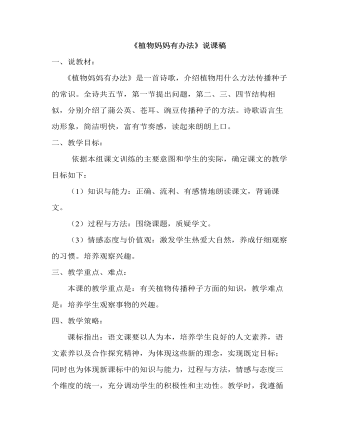
部编人教版二年级上册《植物妈妈有办法》说课稿
一、说教材:《植物妈妈有办法》是一首诗歌,介绍植物用什么方法传播种子的常识。全诗共五节,第一节提出问题,第二、三、四节结构相似,分别介绍了蒲公英、苍耳、豌豆传播种子的方法。诗歌语言生动形象,简洁明快,富有节奏感,读起来朗朗上口。 二、教学目标:依据本组课文训练的主要意图和学生的实际,确定课文的教学目标如下: (1)知识与能力:正确、流利、有感情地朗读课文,背诵课文。(2)过程与方法:围绕课题,质疑学文。(3)情感态度与价值观:激发学生热爱大自然,养成仔细观察的习惯。培养观察兴趣。 三、教学重点、难点:本课的教学重点是:有关植物传播种子方面的知识,教学难点是:培养学生观察事物的兴趣。
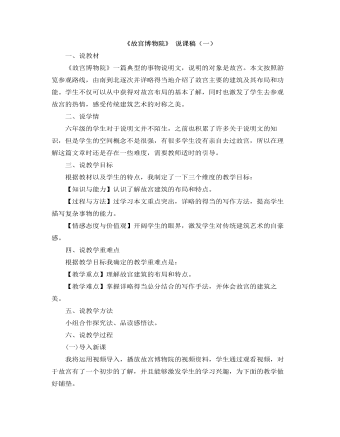
部编人教版六年级上册《故宫博物院》说课稿(一)
一、说教材《故宫博物院》一篇典型的事物说明文,说明的对象是故宫。本文按照游览参观路线,由南到北逐次并详略得当地介绍了故宫主要的建筑及其布局和功能。学生不仅可以从中获得对故宫布局的基本了解,同时也激发了学生去参观故宫的热情,感受传统建筑艺术的对称之美。二、说学情六年级的学生对于说明文并不陌生,之前也积累了许多关于说明文的知识,但是学生的空间概念不是很强,有很多学生没有亲自去过故宫,所以在理解这篇文章时还是存在一些难度,需要教师适时的引导。三、说教学目标根据教材以及学生的特点,我制定了一下三个维度的教学目标:【知识与能力】认识了解故宫建筑的布局和特点。【过程与方法】过学习本文重点突出,详略的得当的写作方法,提高学生描写复杂事物的能力。【情感态度与价值观】开阔学生的眼界,激发学生对传统建筑艺术的自豪感。
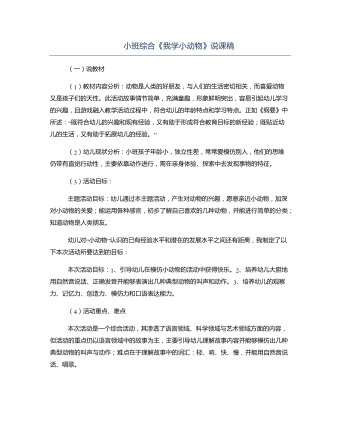
小班综合《我学小动物》说课稿
(1)教材内容分析:动物是人类的好朋友,与人们的生活密切相关,而喜爱动物又是孩子们的天性。此活动故事情节简单,充满童趣,形象鲜明突出,容易引起幼儿学习的兴趣,且游戏融入教学活动过程中,符合幼儿的年龄特点和学习特点。正如《纲要》中所述:“既符合幼儿的兴趣和现有经验,又有助于形成符合教育目标的新经验;既贴近幼儿的生活,又有助于拓展幼儿的经验。”(2)幼儿现状分析:小班孩子年龄小,独立性差,常常爱模仿别人,他们的思维仍带有直觉行动性,主要依靠动作进行,需在亲身体验、探索中去发现事物的特征。(3)活动目标:主题活动目标:幼儿通过本主题活动,产生对动物的兴趣,愿意亲近小动物,加深对小动物的关爱;能运用各种感官,初步了解自己喜欢的几种动物,并能进行简单的分类;知道动物是人类朋友。

人教版高中地理选修3第三章第三节中外著名旅游景观欣赏教案
四、法国巴黎塞纳河畔的古城区城市建筑景观往往可以反映一个城市的发展过程,是城市历史的记录。巴黎的塞纳河沿岸景色优美,古老的塞纳河孕育了不可胜数的古迹,1991年巴黎的塞纳河沿岸作为文化遗产,被联合国教科文组织列入《世界遗产名录》。1.发展历史:2000年以前的巴黎只是塞纳河上西岱岛和附近几个小岛上的渔村,后来逐渐扩大,到3世纪开始有了巴黎这个名字。2.巴黎的建筑艺术和名胜古迹图3.35塞纳河风光通过图片,可以看出:塞纳河畔美丽的风景及城市的繁华。图3.36法国首都巴黎塞纳河畔的著名景点——凯旋门、艾菲尔铁塔夜景、卢浮宫外景、巴黎圣母院外景图文结合介绍巴黎塞纳河畔著名景点的位置及有关情况,重点掌握以下内容:①艾菲尔铁塔是巴黎的象征。卢浮宫原为宫殿群建筑,以收藏古典绘画和雕刻闻名。1793年改为国立美术博物馆。巴黎圣母院教堂为一典型的哥特式建筑。
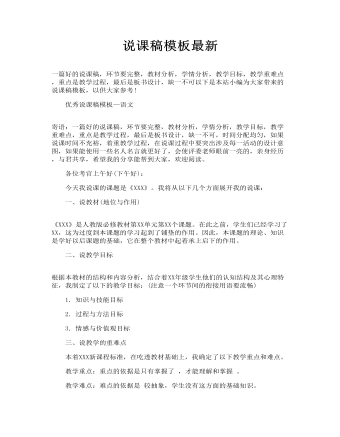
说课稿模板最新
一、说教材(地位与作用) 《XXX》是人教版必修教材第XX单元第XX个课题。在此之前,学生们已经学习了XX,这为过度到本课题的学习起到了铺垫的作用。因此,本课题的理论、知识是学好以后课题的基础,它在整个教材中起着承上启下的作用。 二、说教学目标 根据本教材的结构和内容分析,结合着XX年级学生他们的认知结构及其心理特征,我制定了以下的教学目标:(注意一个环节间的衔接用语要流畅) 1. 知识与技能目标 2. 过程与方法目标 3. 情感与价值观目标

人教版高中地理选修2西南区交通运输建设与区域经济发展教案
1、图9.6“南昆铁路示意图”掌握南昆铁路起止点、支线、途经地区、铁路线附近的矿产资源(云南的磷矿、贵州的煤矿、广西的铝矿等);南昆铁路使西南区南连北海、防城港、湛江、钦州等港,成为西南区通往沿海地区最便捷的出海通道,使西南地区物资出海路程缩短了600千米,对西南区的发展具有十分重要的经济、政治、战略意义。2、图9.10“西南三省一市和广西主要铁路分布图”本图展现了西南三省一市和广西的主要铁路分布,要求重点掌握本区内的环状铁路——成渝-川黔-贵昆-成昆线,新建的南昆线、内昆线,以及宝成线(联系西北区),襄渝线、湘黔线和湘桂-黔桂线(联系中南区),枝柳线(联系中南区和华北区)等区际铁路,昆河线等国际铁路及重要铁路枢纽。3、图9.11“西藏自治区交通图”西藏自治区是我国目前唯一没有正式通铁路的省级行政区,读图后要能掌握联系拉萨的四大入藏(川藏、青藏、新藏、滇藏)公路及正在建设的青藏铁路。

